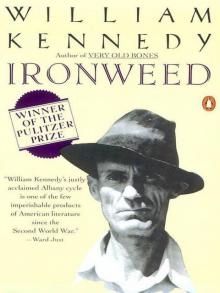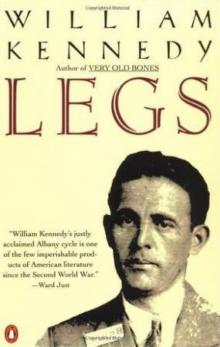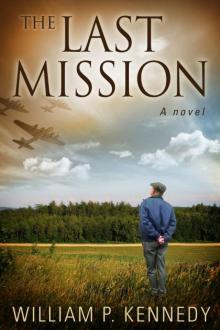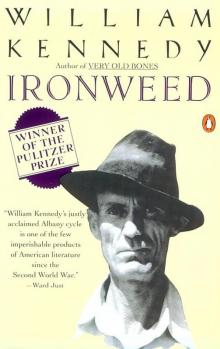- Home
- William Kennedy
The Last Mission
The Last Mission Read online
The Last Mission
by William P. Kennedy
The Last Mission
A Novel
All Rights Reserved © 2013 by William P. Kennedy
No part of this book may be reproduced or transmitted in any form or by any means, graphic, electronic, or mechanical, including photocopying, recording, taping, or by any information storage retrieval system, without the written permission of the publisher.
In Memory of Francis J. Kennedy
First Lieutenant, United States Army Air Force
March, 1943
Scott found the rubble irresistible. The rear brick wall was still more than a story high, its top an uneven course that looked like the rampart of a castle. There were split rafters to climb and enough debris piled up so he could easily look out from the highest point over his imagined kingdom. Or he could go down to the dungeons. The concrete flooring had collapsed on top of vertical posts and was suspended like the canvas of a tent. He could go down under it, and then follow any of the tunnels created by the random fall of the bricks. One of the tunnels opened into a large space, illuminated by streaks of light. Scott could pretend it was light through the barred window of a prison cell.
He knew he had to be careful. The bomb blast had undermined the entire structure, so there were constant rock slides of debris down into the tunnels. The side walls were leaning inward, as if they might collapse at any moment. Local wardens had decided it was too dangerous for amateurs to raze and left it for professional demolition crews. All they had done was rope off the area and post “danger” signs at every corner.
“We’re not to go in there, Scott,” his sister warned from behind him.
“We’re not going in. Just looking about,” he answered. Somehow the eight-year-old boy had to distract his little sister. Sarah had a habit of telling his mother of Scott’s every transgression. His mother had been stern when she ordered the children to keep away.
“Why don’t they knock it down?” all the women in the neighborhood were asking. “There’ll be a little one hurt in there before you know it.”
Scott’s father had explained on several occasions over the past few weeks that all the professional crews were off building airfields. “There’s a war, and we have to tend to it ourselves until the authorities get around to it.”
Norwich had been bombed. The German Heinkels and Dorniers had started with the military airfields, trying to destroy Fighter Command, then they had shifted their missions to the major cities. London had been hammered, and the Thames docks set afire. Coventry was gone. Even Liverpool, clear across the island, had been hit. Norwich, in the center of East Anglia, didn’t seem important enough to bomb, but it had the misfortune of lying directly in the path of German planes coming over from their bases in Belgium and Holland. It had become a convenient place for damaged Germans to lighten their loads on the way home. It was also a popular alternative target for missions flown into the Midlands that were frustrated by weather. As a result, Norwich had been hit heavily—for no particular reason. Buildings were blown up in an absolutely random pattern, all across the city.
But that was all in the past. The cost of bombing raids over England had become prohibitive by early 1942. Heinkels and Dorniers were no match for Spitfires and Hurricanes. German fighters were notoriously short-legged, and couldn’t provide escort on inland missions. By early 1943 there were only a few German planes. An occasional bomber or transport crossed the channel to parachute spies and saboteurs, but these were quick jabs by one or two planes in the middle of the night. The people of Norwich had learned to ignore the warning sirens. The damaged buildings were razed and raked over. Roads were repaired. The German bomb threat was pretty much forgotten.
And then came this. Probably a pair of light, fast bombers striking at a single strategic target. Maybe one of the coastal radio stations used to guide Allied attacks into France, Belgium, and Holland. Or Churchill’s bunker in the heart of London. Whatever the destination, and for whatever reason, one of the planes turned back and kicked out its bomb load over Norwich. The unexpected blast had blown half the city out of bed. Antiaircraft guns were manned. Wardens drew their pistols. Roadblocks were set up. By morning, the full extent of the damage could be seen. A single building—actually a garage for repairing and storing cars—had taken two two-hundred-pounders through the roof. What was left was the shell of the brick wall surrounding a hole filled with debris.
“Scott, Mummy told us not to go in.”
He was standing just inside the line, his shoes coated with the powdery cement. His only hope was to make her an ally.
“Do you see what I see, Sarah?”
“What?” She stepped toward the line.
“I can’t tell you. You have to see it.”
The little girl ducked her head under the rope. “Where?” She took a step toward her brother. “Where should I look?”
He pointed his finger. “Down at the bottom of that tunnel. Come here and I’ll show you.” Scott started forward and Sarah followed cautiously.
“We can’t go down there, Scott. Mummy said.”
“Not all the way. Just down past that wooden post.”
“It could fall in on you.” Sarah tried to sound the warning, just as her mother had. “All those rocks could fall down and crush you.”
“I’m not going under all the way—just as far as that wooden post.”
He stepped down into a hole and ducked under the beam. There were two tunnels. One went to the right, into the room where the light seemed to come from the bars of a prison window; the other turned left and dropped down quickly into a dark, dusty opening. Sarah stooped in next to him. “Where shall I look, Scott? What am I supposed to see?”
“Down here,” he said, pointing to his left. “It’s just a speck further.”
“I’m afraid. We’re not supposed to be in here.”
“You wait right here, Sarah. I’ll bring it back up for you.” He sat on a foundation that marked the edge of the hole, then he pushed forward and let himself slide down a few feet. He had to crouch down again to fit through a masonry arch. Now there were two more paths: a steep shaft that fell to his right and a small chamber straight ahead, the enormous roof of debris held up by a broken beam. He edged himself forward into the darkness, just far enough to see if there were any more lighted rooms.
“I see her,” Sarah said from directly behind him. She had followed him through the arch.
“You shouldn’t have come this far. Go back out and wait for me. I’ll just be a minute.”
“Well, I see her, and I think she looks frightful. Like an old witch.”
He turned. “Who looks like an old witch?”
“Her.” With a fat little finger she pointed down the steep shaft. “The lady.”
Scott turned carefully and looked over his sister’s shoulder. A chalky white face, with red lips and deep-set black eyes, looked back up at him. He gasped in surprise.
“We have to go now,” Sarah insisted. She put her arms on the ledge, but she couldn’t pull herself up. Scott wrapped his arms around her legs and lifted her. She stepped carefully under the arch and made her way back up the tunnel.
The boy turned back for another look at the staring face. It was a woman, lying in a heap, with one leg and one arm folded awkwardly under her and the other leg and arm spread out. Her black dress was up over her hip, so that white skin showed over the top of her stocking. It looked as if she had fallen and was still lying exactly where she had landed. The neck was twisted, with the face turned upward. Her hair was spread out over a dark stain in the dust. Scott could see that one sleeve of her dress was torn at the shoulder.
“Scott, we have to go home.”
“I’m coming, Sara
h.”
She was already past the rope and skipping toward their house when Scott came up from the tunnel and stood, brushing himself off. She would certainly tell their mother exactly what she had seen, and that would make it clear that they had violated her standing order not to play in the rubble of the bombed building. He ran after his sister, hoping to convince her that this should be their secret. They had joined in a conspiracy before they stepped through their front door, but the conspiracy didn’t last as far as the kitchen.
“Mummy, guess what Scott and I saw. A dead lady!”
“Sarah, don’t be silly.”
“It’s true! There’s a dead lady down at the bottom of the tumbledown building.”
Their mother looked at Scott. He knew he was caught, so he decided on a partial truth. “It’s true, Mum, but you don’t have to go down in the rubble. You can see her right from on top of the broken bricks.”
“Well, we won’t be going on the broken bricks, will we. We’ll just tell the wardens.”
Now
You can hear the emptiness of a house.
Emptiness.
Not just the quiet when the family is away or the nighttime silence when everyone is asleep, but the symphony of sound as the air moves, as warmth radiates, as trees bend, as structures settle. Perfectly pleasant to the ear, yet frightening to the spirit, because it reminds us that we are alone.
My house is truly empty. Still furnished, of course, with beds comfortably made and clothes hanging in the closets. With food in the kitchen cupboards and a gas flame that turns on every few hours to keep the water hot. But empty, because no one lives here any longer. And frightening, because I am most certainly alone.
On the deed, it was our house—Kay’s and mine—but it was really hers. She found it when we were living in the city: me getting my start in insurance while she was cubbing at a fashion magazine. She moved us into it the day she told me we were expecting our first child. Then she nurtured it so it grew with our family, reflecting her tastes, just as the children’s faces reflected her blue eyes and their voices echoed her nasal twang. The house was full as long as she was in it. And suddenly it was empty—just as suddenly as she had died.
Her life is recorded everywhere. Kay was a keeper, as I realized when I began sorting through the basement and the attic to get the place ready for sale. Everything she touched was part of a moment, and by holding onto things she tried to keep the moments alive. There were boxes of photographs, primarily of Todd and Kit, documenting every event of their young lives. They were in costumes, atop horses, holding trophies, rowing boats, standing on skis, playing musical instruments. Todd’s documentary stopped abruptly in the late sixties, when the photos began to capture his anger. Kit’s vanished about the same time, and then started up again ten years later, with a baby on her knee.
In the children’s closets I found toys that Kay had packed away, Todd’s football jersey—washed and pressed and hanging as if waiting to be worn—and Kit’s prom dress, folded in tissue paper and packed in a storage box. Kay’s closet held the suit she had worn away from our wedding, and a strapless formal with a mass of crinoline sewed under the skirt. Her dresser drawers were filled with the kids’ diplomas and awards and the embossed certificates the company awarded me each year I qualified as a golden underwriter.
There was nothing valuable, just the kind of debris that passed through the lives of most families formed during the Eisenhower years. All that was different was that Kay kept so much of it, as if the ordinary were somehow extraordinary. I suppose we both assumed that she would be the one getting the house ready for the Realtors, and all this flotsam would become magical memories. With her gone, none of it seemed very magical to me.
Until now…
In a corner of the attic, brightened by a useless dormer window, is a footlocker, perfectly familiar, even while it is long forgotten. A wooden box painted olive drab, with black stenciled lettering:
Cpt James Marron, AAF
ASN 12108169
It has nicely finished edges, piano hinges, and a lock hasp, with an ancient padlock hanging open. The fit is meticulous. Amazing that with all the production priorities of World War II, carpenters were building a million small wooden footlockers, sanding the edges and filling the screw holes. Artists contributing their handicraft to an era of mechanized horror.
I lift the lid and peer long into the past. The cap is on top. An olive-drab officer’s cap, its grommet removed to give the crown a soft, rakish shape. Army Air Force officers were allowed to remove the wire grommets, supposedly so they could wear radio earphones over their caps. It was a distinction forbidden to Navy flyers, who presumably had to make other arrangements to accommodate their headsets, and a license that even generals in the regular army envied.
There are wings—the decorative chest markings of a flyer—pressed out of soft white metal. And shoulder bars: The gold bars of a second lieutenant, the silver of a first lieutenant, and then the captain’s silver-colored double bars. They represented ten years of military promotions, compressed into two years by the needs of service. In 1943 and ’44, when I wore them, Army Air Force captains and lieutenants were falling out of the sky like snowflakes. They could hardly make enough bars for all the young men they put in front of the cannons.
And there are medals: a Distinguished Flying Cross that they gave away like after-dinner mints to just about anyone who survived the carnage and a Purple Heart that was usually a ticket home. You had to be wounded to get the Purple Heart, which meant that your body wasn’t lost somewhere in the clouds, nor was it packed in a canvas bag to facilitate shipment. It was considered an omen of good fortune, like a rabbit’s foot or a four-leaf clover.
I remember that Todd found the footlocker when he was about ten. That would have been in the midsixties. The medals fascinated him, and he brought them to me for an explanation. He seemed proud when I told him why they had been awarded, and he wanted me to display them on the living room mantel. He didn’t understand that all the memories they stirred weren’t pleasant. Todd went back to the footlocker several times more. By the midseventies, when he was bearded and tattered and red-eyed and bewildered, the medals became hateful things—symbols of an oppressive military doing the bidding of a ruthless government. He no longer went near the footlocker, and I suppose Kay decided it was best put out of sight. I know I didn’t open it in the next twenty years, not that I ever missed it.
Beneath the medals are the more commonplace relics of my war: two pair of khaki boxer shorts with the same number of khaki undershirts, calf-length khaki socks, plain-toe military cordovans polished to a mirror shine—all with the smell of camphor from the mothballs that Kay had sprinkled between the layers. As I’ve learned, she was a keeper.
And then the envelope, which I recognize instantly. I can see myself holding it as I did a lifetime ago, sitting on the edge of a hospital bed. When the wound in my leg ended my English tour, there were still people and events that were far from concluded, represented by pictures and letters. I stuffed the documents into a manila envelope and slid them to the bottom of my footlocker. I remember that at the moment, I was honestly determined to deal with them later. They involved important decisions, which I intended to weigh and then pursue courageously. Of course I was only twenty-two at the time. I hadn’t yet learned that the decisions that shape our lives are the ones that are made for us. Nor did I yet realize that they are not sharply defined turning points, but rather the invisible rise of tides whose effects are seen only later, after they recede. The decisions left England with me, in the bottom of the locker, never to be made.
I lift the envelope and bring it into the dormer, close to the light of the window. A part of me wants to tear it open instantly, but there’s another part that advises caution. I’ve spent the past month browsing through the artifacts of a life that ended. It’s best that I don’t add the burden of a life that never was. “Put it back in the box,” this voice tells me. “Bury it with all t
he other things that don’t matter anymore.”
I take it with me as I go down the narrow stairs and switch off the attic light.
In the days following, I decide not to open it. I have to go forward, not backward. Kit visits and sorts through her mother’s clothes and jewelry. She selects two rings, one for each of her daughters so they will have a remembrance of their grandmother. The girls are in college now, and Kit tells me that young women are wearing good jewelry again.
The Realtors invade, marching through the house like tropical ants, opening and closing doors with no feeling for what might be inside. They’re delighted with the bath we’ve added to the master bedroom suite, but have I thought of changing the wallpaper in the living room to something a bit brighter? And I certainly should do something with the worn floor in the kitchen.
Todd calls and says he’s coming down to see me. I spend a few evenings waiting for his arrival, even though I don’t really expect him. He’s still lost between careers, and can’t keep paying plane fares the way he did when Kay was in the hospital. Besides, we’re awkward when we’re together. We still turn away from one another guiltily whenever the conversation lags. With Kay gone, that would probably happen very often.
Now there’s the young couple whom the Realtor assures me are “very interested.” Their bid is much lower than my asking price, and I’m annoyed that the agent, whom I’m paying, seems to be on their side. The bargaining promises to go for another few days, and the price will probably be closer to their figure than to mine. The guy is a futures trader, which means he’s aggressive. I was in insurance, which means I’m cautious.
All the while the envelope sits on the corner of the desk in the bedroom I converted to an office. I still intend to throw it out. I know I will open it, even though I’m sure that I will be sorry I did.

 Riding the Yellow Trolley Car: Selected Nonfiction
Riding the Yellow Trolley Car: Selected Nonfiction Changó's Beads and Two-Tone Shoes
Changó's Beads and Two-Tone Shoes Ironweed
Ironweed The Ink Truck
The Ink Truck Billy Phelan's Greatest Game
Billy Phelan's Greatest Game Legs
Legs Very Old Bones
Very Old Bones The Last Mission
The Last Mission The Flaming Corsage
The Flaming Corsage Roscoe
Roscoe Quinn's Book
Quinn's Book Ironweed (1984 Pulitzer Prize)
Ironweed (1984 Pulitzer Prize) Riding the Yellow Trolley Car
Riding the Yellow Trolley Car Legs - William Kennedy
Legs - William Kennedy